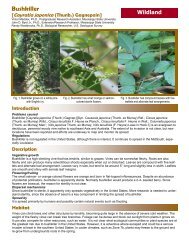RATopic1_95 - Geosystems Research Institute - Mississippi State ...
RATopic1_95 - Geosystems Research Institute - Mississippi State ...
RATopic1_95 - Geosystems Research Institute - Mississippi State ...
Create successful ePaper yourself
Turn your PDF publications into a flip-book with our unique Google optimized e-Paper software.
Task 1.2. Nonindigenous Aquatic Plant Database Plant Observation Entry<br />
PI: John Madsen<br />
Collaborator: Pam Fuller, USGS Caribbean Science Center<br />
Hydrilla and Giant Salvinia Survey in <strong>Mississippi</strong> for 2009<br />
Michael C. Cox, John D. Madsen and Ryan M. Wersal<br />
Water bodies in <strong>Mississippi</strong> provide recreational opportunities, fishing,<br />
transportation, municipal and drinking supply, and wildlife habitat.<br />
Invasive aquatic plant species negatively affect all of these when<br />
introduced to water bodies. Hydrilla [Hydrilla verticillata (L.f.)<br />
Royle] and giant salvinia (Salvinia molesta D. S. Mitchell) are two<br />
aquatic plants that are non-native and present in <strong>Mississippi</strong> waterbodies.<br />
Hydrilla is a submersed aquatic plant native to warmer areas<br />
of Asia and has become a serious nuisance plant in the United <strong>State</strong>s<br />
(Langeland 1996). The specialized growth habit, reproduction, and<br />
physiological properties of hydrilla make it superior to neighboring<br />
plant species in the gathering of light, nutrients, and oxygen. For this<br />
reason, hydrilla has the well-deserved nickname “the perfect aquatic<br />
weed”. Although both dioecious and monoecious biotypes of hydrilla<br />
exist in the United <strong>State</strong>s, only the dioecious biotype occurs in<br />
<strong>Mississippi</strong>. Hydrilla can reproduce by fragmentation and through<br />
the production of turions and tubers (subterranean turions). Giant<br />
salvinia is a free-floating aquatic fern native to southeastern Brazil.<br />
It primarily reproduces asexually (daughter plants arising from buds<br />
on stolons) and may double in leaf number in less than 8 days<br />
(McFarland et al. 2004). The rapid growth rate and proficient reproduction<br />
methods of giant salvinia make it an extreme nuisance and<br />
competitor in aquatic environments.<br />
Figure 1. Locations of hydrilla and giant salvinia<br />
distribution in <strong>Mississippi</strong>. Included are points surveyed<br />
from 2005 to 2009.<br />
Methodology<br />
Figure 2. Giant salvinia population in Wedgeworth Creek, Forrest<br />
County, MS, during May 2007. GRI Photo.<br />
Surveys to detect the presence or absence of hydrilla<br />
and giant salvinia have been conducted<br />
across <strong>Mississippi</strong> since 2005. Locations surveyed<br />
in 2009 were previously non-surveyed areas,<br />
while the Ross Barnett Reservoir, Wedgeworth<br />
Creek, and Pascagoula River Delta were<br />
revisited for an update on hydrilla or giant salvinia<br />
occurrence after they were detected in previous<br />
surveys. A Hewlett-Packard model 2110 iPAQ<br />
handheld computer with Global Positioning System<br />
(GPS) capabilities via a Holux GPS model<br />
GR-271 receiver was used to obtain geographic<br />
locations at approximately 3 m position accuracy.<br />
All data was collected and reported in latitude and<br />
longitude under datum WGS 84. Location maps<br />
with present points were produced using ArcGIS-<br />
ArcMap, version 9.2.<br />
2009 USGS Annual Report 12 <strong>Mississippi</strong> <strong>State</strong> University’s <strong>Geosystems</strong> <strong>Research</strong> <strong>Institute</strong>




